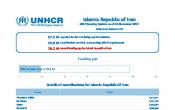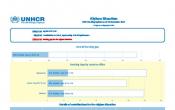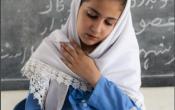Islamic Republic of Iran
Operation: Islamic Republic of Iran
Location
{"longitude":55,"latitude":33,"zoom_level":5}
Latest update of camps and office locations 21 Nov 2016. By clicking on the icons on the map, additional information is displayed.
Key Figures
| 2018 planning figures | |
| 89% | of primary school aged refugee children will be enrolled in primary education |
| 80% | of Afghan and Iraqi refugee households will have their basic and domestic items needs met |
| 300 | Afghan refugees will be provided with entrepreneurship/business training |
| 15 | projects benefiting local and displaced communities will be implemented and 1,660 households will be reached with cash support |
| 39 | schools will be built to ensure that 15,600 refugee and host-community children benefit from additional schooling space |
| 2016 end-year results | |
| 145,200 | refugees were enrolled in the national health insurance scheme, out of whom over 117,000 were vulnerable refugees |
| 412 | students were supported with DAFI scholarships |
| 16 | schools were constructed |
Latest Updates
People of Concern
0%
Increase in
2016
2016
| 2016 | 979,537 |
| 2015 | 979,491 |
| 2014 | 982,085 |

[["Refugees",979435],["Asylum-seekers",91],["Returned refugees",11]]
Loading ...
Islamic Republic of Iran
< Back
2016
{"categories":[2013,2014,2015,2016,2017,2018],"budget":[59.5882886,68.48044209,72.823781737,76.76538033,97.24654417,98.756622182],"expenditure":[38.43715452,30.14519856,21.93132368,36.211779,null,null]}
{"categories":[2013,2014,2015,2016,2017,2018],"p1":[59.5882886,68.48044209,72.823781737,76.76538033,97.24654417,98.756622182],"p2":[null,null,null,null,null,null],"p3":[null,null,null,null,null,null],"p4":[null,null,null,null,null,null]}
{"categories":[2013,2014,2015,2016,2017,2018],"p1":[38.43715452,30.14519856,21.93132368,36.211779,null,null],"p2":[null,null,null,null,null,null],"p3":[null,null,null,null,null,null],"p4":[null,null,null,null,null,null]}
Loading ...
CHOOSE A YEAR
- 2014
- 2015
- 2016
- 2017
- 2018
Year-end Overview
Plan Overview
Working environment
The Islamic Republic of Iran is host to one of the largest and most protracted urban refugee populations worldwide. More than 3 million Afghans, including registered refugees, passport holders and undocumented, reside in Iran. The Government is responsible for registering refugees and issuing identity cards (Amayesh). Approximately 97 per cent of the registered refugees live in urban areas while 3 per cent reside in 20 settlements. UNHCR assists the registered Amayesh cardholders. In addition to registered refugees, according to the Government’s estimation, Iran hosts around 620,000 Afghans who hold Afghan passports and Iranian visas, and more than 1 million undocumented Afghans. A countrywide exercise to identify the undocumented took place in 2017. It initially targeted only Afghans but was extended to Iraqis after a few months. According to the Government more than 800,000 undocumented foreign nationals were identified during the headcount by mid-September 2017.
The Islamic Republic of Iran opened access to all refugees into the Universal Public Health Insurance (UPHI) that provides refugees with health insurance services similar to that of Iranian nationals. To date, more than 110,000 extremely vulnerable refugees have enrolled in the third cycle of UPHI scheme (providing coverage for 12 months. Undocumented Afghan children are now allowed to access formal education. More than 420,000 refugee children are enrolled in primary and secondary school, out of which over 72,000 are undocumented Afghan children.
Voluntary repatriation has continued to decrease as the situation in Afghanistan deteriorates further, as a result, only 930 refugees voluntarily repatriated in the period between January and September 2017. In this context, resettlement remains an important durable solution. However, resettlement quotas have been on the decline over the past few years, and UNHCR was offered to resettle less than 240 individuals in 2017. Concerted efforts will be made to increase available resettlement quotas for Iran, as well as to engage in the alternative pathways to third country solutions.
The Government of the Islamic Republic of Iran continues to play an active role in the process of ‘Solutions Strategy for Afghan refugees to support voluntary repatriation, sustainable reintegration and assistance to host countries’. BAFIA has the overall responsibility of coordinating refugee affairs in coordination with other line ministries, such as the Ministries of Health and Education. UNHCR will continue to work closely with other UN agencies and its NGO partners, including through leading thematic working groups. UNHCR and partners remain engaged in interagency contingency planning preparedness under UNHCR’s leadership.
Key priorities
In 2018, UNHCR will focus on:
- Ensuring that the asylum space is expanded to all refugees. Focus will be on issues relating to access to asylum, registration and documentation;
- Supporting the Government to expand the school infrastructure to enrol and provide access to refugees, undocumented and local children;
- Supporting the Government efforts to continue extending UPHI to identified extremely vulnerable refugees along the line of the 6th National Development strategy;
- Supporting refugees to have access to diversified livelihoods opportunities.
- Addressing the immediate needs of vulnerable refugees by providing cash support;



